weight Seat Ibiza SC 2008 Owner's manual
[x] Cancel search | Manufacturer: SEAT, Model Year: 2008, Model line: Ibiza SC, Model: Seat Ibiza SC 2008Pages: 258, PDF Size: 7.93 MB
Page 17 of 258
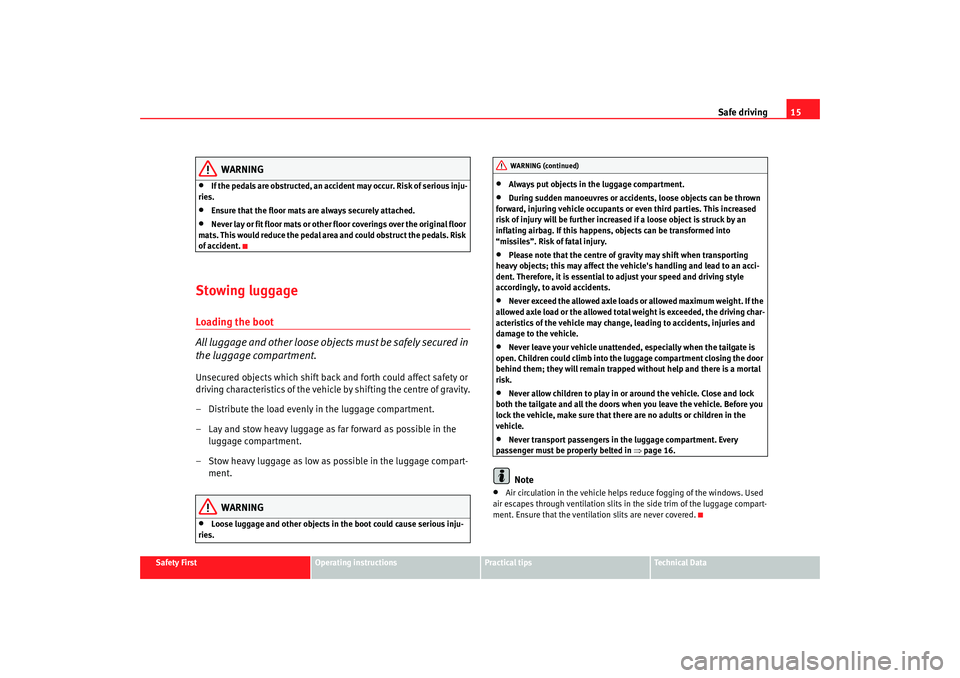
Safe driving15
Safety First
Operating instructions
Practical tips
Te c h n i c a l D a t a
WARNING
•
If the pedals are obstructed, an accide nt may occur. Risk of serious inju-
ries.
•
Ensure that the floor mats are always securely attached.
•
Never lay or fit floor mats or other floor coverings over the original floor
mats. This would reduce the pedal area and could obstruct the pedals. Risk
of accident.
Stowing luggageLoading the boot
All luggage and other loose object s must be safely secured in
the luggage compartment.Unsecured objects which shift back and forth could affect safety or
driving characteristics of the vehicle by shifting the centre of gravity.
– Distribute the load evenly in the luggage compartment.
– Lay and stow heavy luggage as far forward as possible in the luggage compartment.
– Stow heavy luggage as low as possible in the luggage compart- ment.
WARNING
•
Loose luggage and other objects in the boot could cause serious inju-
ries.
•
Always put objects in the luggage compartment.
•
During sudden manoeuvres or accidents, loose objects can be thrown
forward, injuring vehicle occupants or even third parties. This increased
risk of injury will be further increased if a loose object is struck by an
inflating airbag. If this happens, objects can be transformed into
“missiles”. Risk of fatal injury.
•
Please note that the centre of gravity may shift when transporting
heavy objects; this may affect the vehicle's handling and lead to an acci-
dent. Therefore, it is essential to adjust your speed and driving style
accordingly, to avoid accidents.
•
Never exceed the allowed axle loads or allowed maximum weight. If the
allowed axle load or the allowed total weight is exceeded, the driving char-
acteristics of the vehicle may change, leading to accidents, injuries and
damage to the vehicle.
•
Never leave your vehicle unattended, especially when the tailgate is
open. Children could climb into the luggage compartment closing the door
behind them; they will remain trapped without help and there is a mortal
risk.
•
Never allow children to play in or around the vehicle. Close and lock
both the tailgate and all the doors when you leave the vehicle. Before you
lock the vehicle, make sure that ther e are no adults or children in the
vehicle.
•
Never transport passengers in the luggage compartment. Every
passenger must be properly belted in ⇒ page 16.Note
•
Air circulation in the vehicle helps reduce fogging of the windows. Used
air escapes through ventilation slits in the side trim of the luggage compart-
ment. Ensure that the ventil ation slits are never covered.WARNING (continued)
Ibiza SC_EN.book Seite 15 Dienstag, 8. Juli 2008 5:36 17
Page 18 of 258
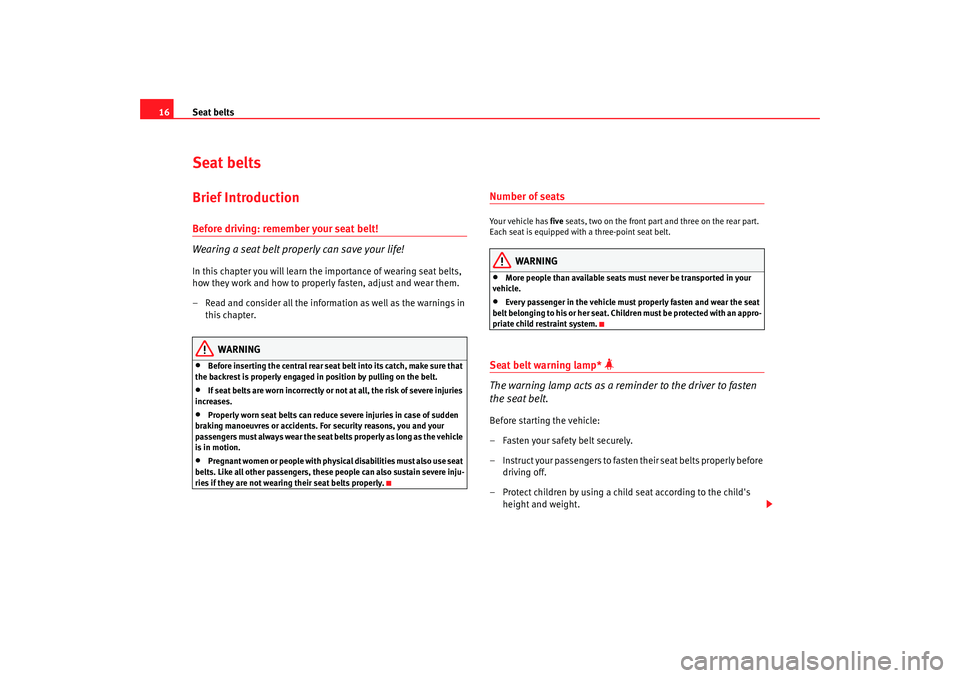
Seat belts
16Seat beltsBrief IntroductionBefore driving: remember your seat belt!
Wearing a seat belt properly can save your life!In this chapter you will learn the importance of wearing seat belts,
how they work and how to properly fasten, adjust and wear them.
– Read and consider all the information as well as the warnings in
this chapter.
WARNING
•
Before inserting the central rear seat belt into its catch, make sure that
the backrest is properly engaged in position by pulling on the belt.
•
If seat belts are worn incorrectly or no t at all, the risk of severe injuries
increases.
•
Properly worn seat belts can reduce severe injuries in case of sudden
braking manoeuvres or accidents. For security reasons, you and your
passengers must always wear the seat belts properly as long as the vehicle
is in motion.
•
Pregnant women or people with physica l disabilities must also use seat
belts. Like all other passengers, these people can also sustain severe inju-
ries if they are not wearing their seat belts properly.
Number of seatsYour vehicle has five seats, two on the front part and three on the rear part.
Each seat is equipped with a three-point seat belt.
WARNING
•
More people than available seats must never be transported in your
vehicle.
•
Every passenger in the vehicle must properly fasten and wear the seat
belt belonging to his or her seat. Children must be protected with an appro-
priate child restraint system.
Seat belt warning lamp*
The warning lamp acts as a reminder to the driver to fasten
the seat belt.Before starting the vehicle:
– Fasten your safety belt securely.
– Instruct your passengers to fasten their seat belts properly before driving off.
– Protect children by using a child seat according to the child's height and weight.
Ibiza SC_EN.book Seite 16 Dienstag, 8. Juli 2008 5:36 17
Page 20 of 258
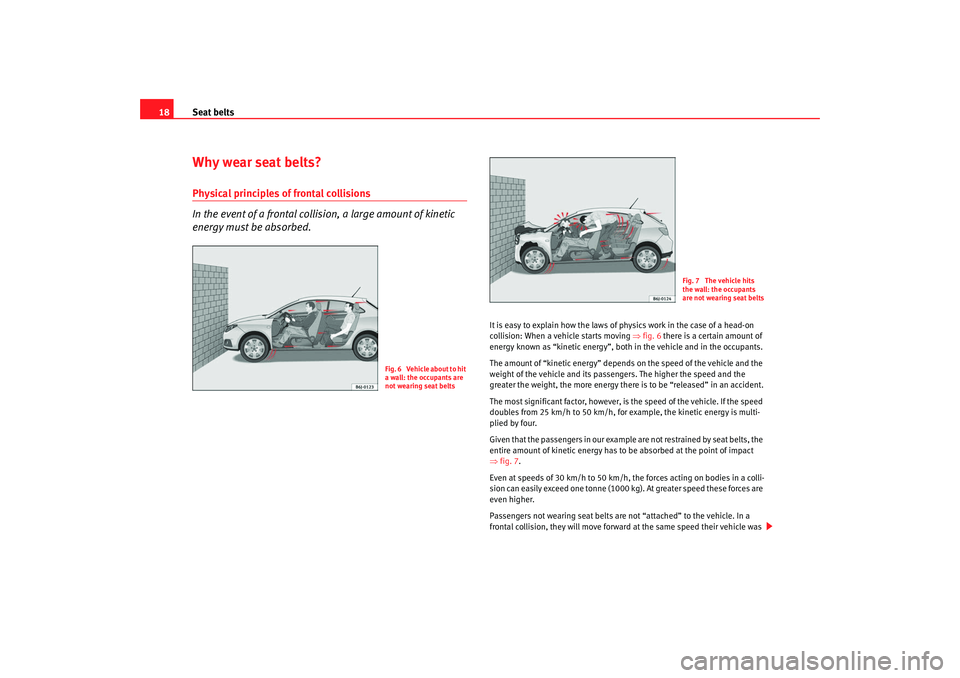
Seat belts
18Why wear seat belts?Physical principles of frontal collisions
In the event of a frontal collision, a large amount of kinetic
energy must be absorbed.
It is easy to explain how the laws of physics work in the case of a head-on
collision: When a vehicle starts moving ⇒fig. 6 there is a certain amount of
energy known as “kinetic energy”, both in the vehicle and in the occupants.
The amount of “kinetic energy” depends on the speed of the vehicle and the
weight of the vehicle and its passengers. The higher the speed and the
greater the weight, the more energy there is to be “released” in an accident.
The most significant factor, however, is the speed of the vehicle. If the speed
doubles from 25 km/h to 50 km/h, for example, the kinetic energy is multi-
plied by four.
Given that the passengers in our example are not restrained by seat belts, the
entire amount of kinetic energy has to be absorbed at the point of impact
⇒ fig. 7 .
Even at speeds of 30 km/h to 50 km/h, the forces acting on bodies in a colli-
sion can easily exceed one tonne (1000 kg). At greater speed these forces are
even higher.
Passengers not wearing seat belts are not “attached” to the vehicle. In a
frontal collision, they will move forward at the same speed their vehicle was
Fig. 6 Vehicle about to hit
a wall: the occupants are
not wearing seat belts
Fig. 7 The vehicle hits
the wall: the occupants
are not wearing seat belts
Ibiza SC_EN.book Seite 18 Dienstag, 8. Juli 2008 5:36 17
Page 28 of 258
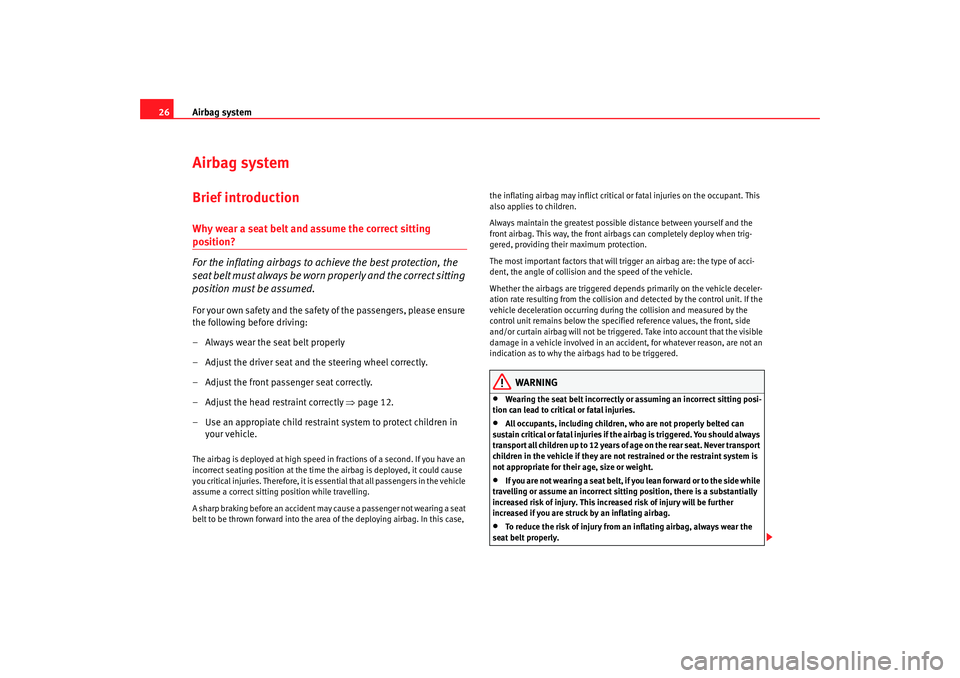
Airbag system
26Airbag systemBrief introductionWhy wear a seat belt and assume the correct sitting position?
For the inflating airbags to achieve the best protection, the
sea t b el t m u st al w ay s b e w o rn p ro p e rly a nd t h e co rrec t s i tt i n g
position must be assumed.For your own safety and the safety of the passengers, please ensure
the following before driving:
– Always wear the seat belt properly
– Adjust the driver seat and the steering wheel correctly.
– Adjust the front passenger seat correctly.
– Adjust the head restraint correctly ⇒page 12.
– Use an appropiate child restraint system to protect children in your vehicle.The airbag is deployed at high speed in fractions of a second. If you have an
incorrect seating position at the time the airbag is deployed, it could cause
you critical injuries. Therefore, it is essential that all passengers in the vehicle
assume a correct sitting position while travelling.
A sharp braking before an accident may cause a passenger not wearing a seat
belt to be thrown forward into the area of the deploying airbag. In this case, the inflating airbag may inflict critical or fatal injuries on the occupant. This
also applies to children.
Always maintain the greatest possible distance between yourself and the
front airbag. This way, the front airbags can completely deploy when trig-
gered, providing their maximum protection.
The most important factors that will trigger an airbag are: the type of acci-
dent, the angle of collision and the speed of the vehicle.
Whether the airbags are triggered depends primarily on the vehicle deceler-
ation rate resulting from the collision an
d detected by the control unit. If the
vehicle deceleration occurring duri ng the collision and measured by the
control unit remains below the specifie d reference values, the front, side
and/or curtain airbag will not be triggered. Take into account that the visible
damage in a vehicle involved in an accident, for whatever reason, are not an
indication as to why the airbags had to be triggered.
WARNING
•
Wearing the seat belt incorrectly or assuming an incorrect sitting posi-
tion can lead to critical or fatal injuries.
•
All occupants, including children, who are not properly belted can
sustain critical or fatal injuries if the airbag is triggered. You should always
transport all children up to 12 years of age on the rear seat. Never transport
children in the vehicle if they are not restrained or the restraint system is
not appropriate for their age, size or weight.
•
If you are not wearing a seat belt, if you lean forward or to the side while
travelling or assume an incorrect sitting position, there is a substantially
increased risk of injury. This increased risk of injury will be further
increased if you are struck by an inflating airbag.
•
To reduce the risk of injury from an inflating airbag, always wear the
seat belt properly.
Ibiza SC_EN.book Seite 26 Dienstag, 8. Juli 2008 5:36 17
Page 36 of 258
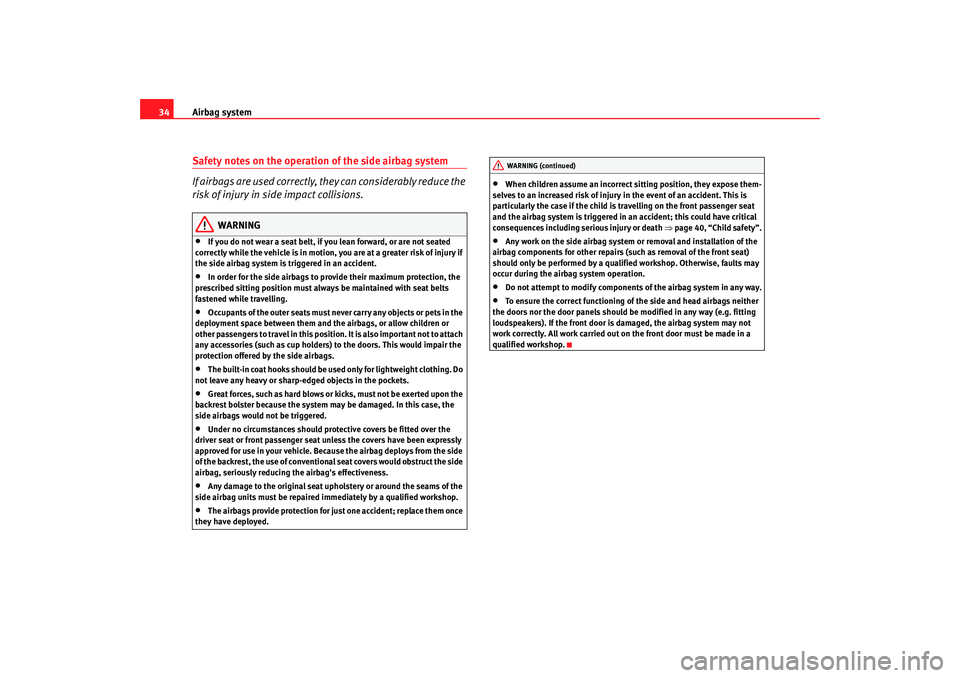
Airbag system
34Safety notes on the operation of the side airbag system
If airbags are used correctly, they can considerably reduce the
risk of injury in side impact collisions.
WARNING
•
If you do not wear a seat belt, if you lean forward, or are not seated
correctly while the vehicle is in motion, you are at a greater risk of injury if
the side airbag system is triggered in an accident.
•
In order for the side airbags to provide their maximum protection, the
prescribed sitting position must always be maintained with seat belts
fastened while travelling.
•
Occupants of the outer seats must never carry any objects or pets in the
deployment space between them and th e airbags, or allow children or
other passengers to travel in this position. It is also important not to attach
any accessories (such as cup holders) to the doors. This would impair the
protection offered by the side airbags.
•
The built-in coat hooks should be used only for lightweight clothing. Do
not leave any heavy or sharp-edged objects in the pockets.
•
Great forces, such as hard blows or kicks, must not be exerted upon the
backrest bolster because the system ma y be damaged. In this case, the
side airbags would not be triggered.
•
Under no circumstances should protective covers be fitted over the
driver seat or front passenger seat unless the covers have been expressly
approved for use in your vehicle. Because the airbag deploys from the side
of the backrest, the use of conventional seat covers would obstruct the side
airbag, seriously reducing the airbag's effectiveness.
•
Any damage to the original seat upho lstery or around the seams of the
side airbag units must be repaired immediately by a qualified workshop.
•
The airbags provide protection for just one accident; replace them once
they have deployed.
•
When children assume an incorrect si tting position, they expose them-
selves to an increased risk of injury in the event of an accident. This is
particularly the case if the child is travelling on the front passenger seat
and the airbag system is triggered in an accident; this could have critical
consequences including serious injury or death ⇒page 40, “Child safety”.
•
Any work on the side airbag system or removal and installation of the
airbag components for other repairs (such as removal of the front seat)
should only be performed by a qualified workshop. Otherwise, faults may
occur during the airbag system operation.
•
Do not attempt to modify components of the airbag system in any way.
•
To ensure the correct functioning of the side and head airbags neither
the doors nor the door p anels should be modified in any way (e.g. fitting
loudspeakers). If the front door is damaged, the airbag system may not
work correctly. All work carried out on the front door must be made in a
qualified workshop.WARNING (continued)
Ibiza SC_EN.book Seite 34 Dienstag, 8. Juli 2008 5:36 17
Page 38 of 258
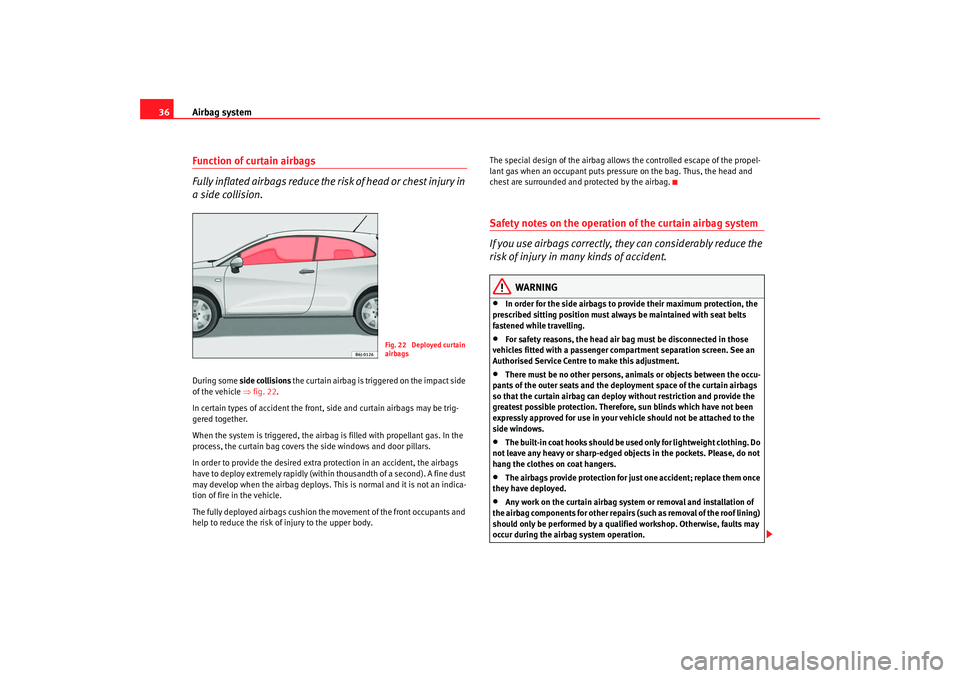
Airbag system
36Function of curtain airbags
Fully inflated airbags reduce the ri sk of head or chest injury in
a side collision.During some side collisions the curtain airbag is tri ggered on the impact side
of the vehicle ⇒fig. 22 .
In certain types of accident the front, side and curtain airbags may be trig-
gered together.
When the system is triggered, the airbag is filled with propellant gas. In the
process, the curtain bag covers the side windows and door pillars.
In order to provide the desired extra protection in an accident, the airbags
have to deploy extremely rapidly (within thousandth of a second). A fine dust
may develop when the airbag deploys. This is normal and it is not an indica-
tion of fire in the vehicle.
The fully deployed airbags cushion the movement of the front occupants and
help to reduce the risk of injury to the upper body. The special design of the airbag allows the controlled escape of the propel-
lant gas when an occupant puts pressure on the bag. Thus, the head and
chest are surrounded and protected by the airbag.
Safety notes on the operation of the curtain airbag system
If you use airbags correctly, they can considerably reduce the
risk of injury in many kinds of accident.
WARNING
•
In order for the side airbags to provide their maximum protection, the
prescribed sitting position must alwa ys be maintained with seat belts
fastened while travelling.
•
For safety reasons, the head air bag must be disconnected in those
vehicles fitted with a passenger compartment separation screen. See an
Authorised Service Centre to make this adjustment.
•
There must be no other persons, animals or objects between the occu-
pants of the outer seats and the depl oyment space of the curtain airbags
so that the curtain airbag can deploy without restriction and provide the
greatest possible protection. Therefor e, sun blinds which have not been
expressly approved for use in your ve hicle should not be attached to the
side windows.
•
The built-in coat hooks should be us ed only for lightweight clothing. Do
not leave any heavy or sharp-edged objects in the pockets. Please, do not
hang the clothes on coat hangers.
•
The airbags provide protection for just one accident; replace them once
they have deployed.
•
Any work on the curtain airbag system or removal and installation of
the airbag components for other repairs (such as removal of the roof lining)
should only be performed by a qualified workshop. Otherwise, faults may
occur during the airbag system operation.
Fig. 22 Deployed curtain
airbags
Ibiza SC_EN.book Seite 36 Dienstag, 8. Juli 2008 5:36 17
Page 42 of 258

Child safety
40Child safetyBrief introductionIntroduction
Statistics show that children are generally safer on the rear
seat than on the front passenger seat.We recommend that children under 12 years of age are transported on the
rear seats. Children travelling on the rear seat must use a child restraint
system or the seat belts provided, depending on their age, height and
weight. For safety reasons, the child restraint system should be installed in
the centre of the rear seat or behind the front passenger's seat.
The physical laws involved and the forces acting in a collision apply also to
children. ⇒page 18, “Why wear seat belts?”. But unlike adults, children do
not have muscle and bone structures fu lly developed. This means that chil-
dren are subject to a greater risk of injury.
To reduce this risk, children must always use special child restraint systems
when travelling in the vehicle.
We recommend the use of child safety products from the SEAT Genuine Acces-
sories Program, which includes systems for all ages made by “Peke”
2).
These systems have been especially designed and approved, complying with
the ECE-R44. regulation.
Follow the manufacturer's instructions and observe any statutory require-
ments when installing and using child seats. Always read and note
⇒ page 41, “Safety notes on using child seats”. We recommend you to include together
with the on-board documentation,
the manufacturer's Child Seat instructions manual.
2)Not for all countries
Ibiza SC_EN.book Seite 40 Dienstag, 8. Juli 2008 5:36 17
Page 44 of 258
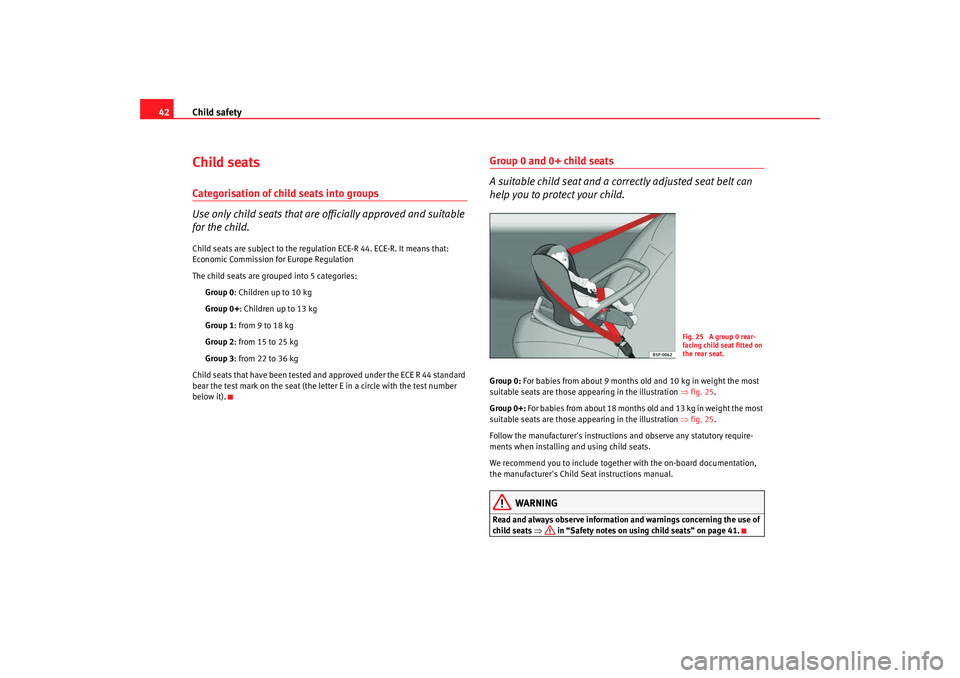
Child safety
42Child seatsCategorisation of child seats into groups
Use only child seats that are officially approved and suitable
for the child.Child seats are subject to the regulation ECE-R 44. ECE-R. It means that:
Economic Commission for Europe Regulation
The child seats are grouped into 5 categories:
Group 0: Children up to 10 kg
Group 0+ : Children up to 13 kg
Group 1: from 9 to 18 kg
Group 2: from 15 to 25 kg
Group 3: from 22 to 36 kg
Child seats that have been tested and approved under the ECE R 44 standard
bear the test mark on the seat (the letter E in a circle with the test number
below it).
Group 0 and 0+ child seats
A suitable child seat and a corr ectly adjusted seat belt can
help you to protect your child.Group 0: For babies from about 9 months ol d and 10 kg in weight the most
suitable seats are those appearing in the illustration ⇒fig. 25 .
Group 0+: For babies from about 18 months old and 13 kg in weight the most
suitable seats are those appearing in the illustration ⇒fig. 25 .
Follow the manufacturer's instructions and observe any statutory require-
ments when installing and using child seats.
We recommend you to include together with the on-board documentation,
the manufacturer's Child Seat instructions manual.
WARNING
Read and always observe information and warnings concerning the use of
child seats ⇒ in “Safety notes on using child seats” on page 41.
Fig. 25 A group 0 rear-
facing child seat fitted on
the rear seat.
Ibiza SC_EN.book Seite 42 Dienstag, 8. Juli 2008 5:36 17
Page 47 of 258

Child safety45
Safety First
Operating instructions
Practical tips
Te c h n i c a l D a t a
Securing child seatsWays to secure a child seat
A child seat can be secured differently on th e rear seat and on the front passenger seat.You can secure a child seat to the rear seat or front passenger seat in the
following ways:•
Child seats in groups 0 to 3 can be secured with a seat belt.
•
Child seats for groups 0, 0+ and 1 with the “ISOFIX” system can be
secured, without fastening seat belts, with the “ISOFIX” securing rings
⇒ page 46.
U: Suitable for universal approved rest raining systems for use in this age
category (universal retention systems are those fitted using the adult
seat belt).
UF Suitable for universal forward-facing retention systems approved for use with this age group.
*: Move the passenger seat as far to rear as possible, as high as possible and always deactivate the airbag.
L: Suitable for retention system s using the “ISOFIX” anchors
X Seat position not suitable for children in this age group.
WARNING
•
When travelling, children must be secured in the vehicle with a
restraint system suitable for age, weight and size.
•
Never install a child seat facing backwards (or rear-facing) on the front
passenger seat unless the front passenger airbag has been disabled. This
could cause fatal injuries to the child! However, if it is necessary, in excep-
tional cases, to transport a child in the front passenger seat, the front
passenger airbag must always be disabled ⇒page 38, “Deactivating
airbags*” and move the seat to its h ighest position, in case it has this
adjustment.
•
Read and always observe information and warnings concerning the use
of child seats ⇒ in “Safety notes on using child seats” on page 41.
Category
Weight Seat locations
Front passenger Rear outerRear centre
Group 0 <10 kgU*UU
Group 0+ <13 kgU*UU
Group 1 9-18 kgU*U/L U
Group 2 / 3 15-36 kgXUF UFWARNING (continued)
Ibiza SC_EN.book Seite 45 Dienstag, 8. Juli 2008 5:36 17
Page 107 of 258
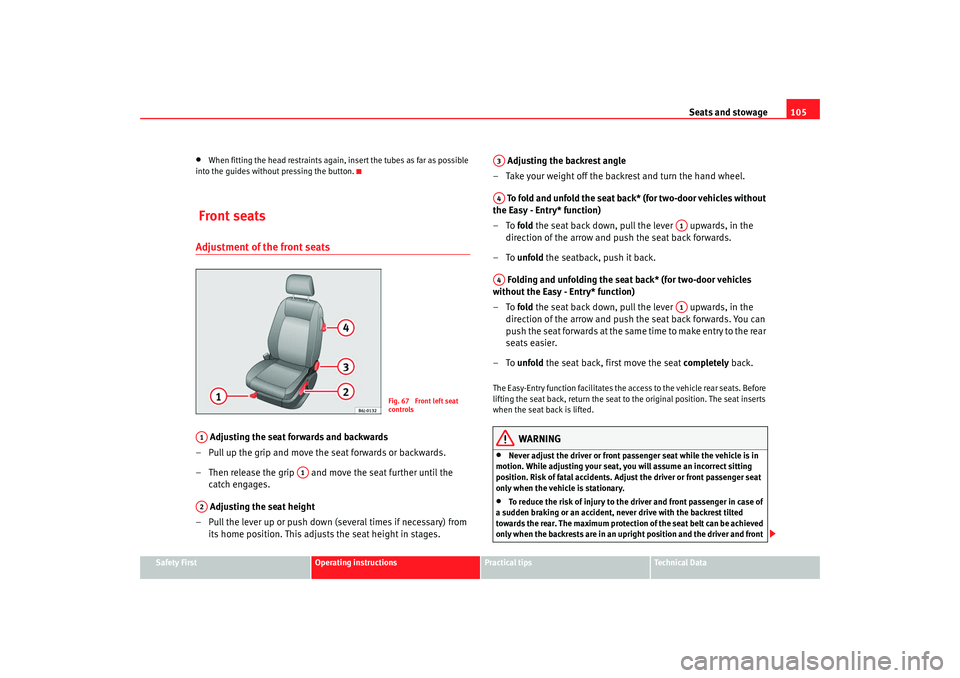
Seats and stowage105
Safety First
Operating instructions
Practical tips
Te c h n i c a l D a t a
•
When fitting the head restraints again, insert the tubes as far as possible
into the guides without pressing the button.
Front seatsAdjustment of the front seats
Adjusting the seat forwards and backwards
– Pull up the grip and move the seat forwards or backwards.
– Then release the grip and move the seat further until the catch engages.
Adjusting the seat height
– Pull the lever up or push down (several times if necessary) from its home position. This adjusts the seat height in stages. Adjusting the backrest angle
– Take your weight off the backrest and turn the hand wheel.
To fold and unfold the seat back* (for two-door vehicles without
the Easy - Entry* function)
–To fold the seat back down, pull the lever upwards, in the
direction of the arrow and push the seat back forwards.
–To unfold the seatback, push it back.
Folding and unfolding the seat back* (for two-door vehicles
without the Easy - Entry* function)
–To fold the seat back down, pull the lever upwards, in the
direction of the arrow and push the seat back forwards. You can
push the seat forwards at the same time to make entry to the rear
seats easier.
–To unfold the seat back, first move the seat completely back.
The Easy-Entry function facilitates the access to the vehicle rear seats. Before
lifting the seat back, return the seat to the original position. The seat inserts
when the seat back is lifted.
WARNING
•
Never adjust the driver or front passenger seat while the vehicle is in
motion. While adjusting your seat, you will assume an incorrect sitting
position. Risk of fatal accidents. Adjust the driver or front passenger seat
only when the vehicle is stationary.
•
To reduce the risk of injury to the driver and front passenger in case of
a sudden braking or an accident, never drive with the backrest tilted
towards the rear. The maximum protection of the seat belt can be achieved
only when the backrests are in an upright position and the driver and front
Fig. 67 Front left seat
controls
A1
A1
A2
A3A4
A1
A4
A1
Ibiza SC_EN.book Seite 105 Dienstag, 8. Juli 2008 5:36 17